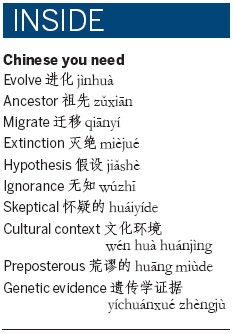The Peking man delusion
Updated: 2013-10-04 09:00
By Yuan Ren (China Daily)
|
|||||||||||
A nation coping with a dying theory 我们的祖先到底是"北京猿人" 还是非洲 "夏娃"?
While waves were sent shockwaves through the intellectual world in 1987 as DNA evidence hailed a woman living 200,000 years ago in Africa as the earliest common ancestor (祖先 zǔxiān) to all modern humans, many of China's scientists held up the theory that an archaic form of human, the Peking man (北京猿人 běijīng yuánrén), was the true ancestor of the modern Chinese.
Over the next 30 years, as the model of a common African origin gained momentum with growing genetic and archaeological (考古学的 kǎogǔxuéde) evidence, the theory evolved into a an accepted narrative of human evolution, depicting an early form of modern humans emerging out of Africa about 60,000 years ago.
The scientific community rejected the competing theory that supported independent evolution in different parts of the world. But in China, the revelation barely rippled with a nation that teaches in its history and text books that the Peking man was the real deal.
The Peking man in question - a Homo erectus, or upright man, that lived 750,000 years ago - was discovered in Zhoukoudian (周口店), southwest Beijing in 1929. At the time, they were the oldest fossils
(化石 huàshí) of man known, fanning flames for theories that all humans originated in China.
These believers were at least right about one point: common originality. "Based on evolutionary theory, all modern humans have to share a common ancestor at some point in the past," says Mark Stoneking, of the Max Planck Institute for Evolutionary Anthropology.
"The evidence for this is extremely strong from all fields of anthropology and genetics. The controversy is over how far back in the past this common ancestor is."
Indeed, apart from the occasional loon, what most leading scientists, including the Chinese, can now agree on is that about 2 million years ago during the Pleistocene era, primates in Africa evolved into Homo erectus on the African continent.
This species was able to cover greater distances due to its upright form, and with climate conditions permitting, a sub-population of this species successfully migrated out of Africa, spreading to Asia and other parts of the world, giving rise to populations such as the Peking man.
While academics in China are still debating with each other, the Chinese public is less than perturbed by stirrings in the scientific realm.
Zhang Yanfang, a 67-year-old Beijinger and retired office manager, on learning of the Africa theory, says that she was not even aware such a hypothesis existed. "I've never heard of such a thing," Zhang says, adding that she grew up learning, like every other Chinese person, that she descended from the Peking man.
"I think it's quite unlikely that we are related to Africans; the difference is too great in every respect - including that of race," she says.
Professor Frank Dikotter, Chair Professor of Humanities at the University of Hong Kong and author of The Discourse of Race in Modern China, believes that intellectualism can be strongly influenced by a cultural context, noting a similar resistance in the West to the multiple origins theory in the 19th century.
"Monogenesis until recently was a view with its own cultural background. Despite the fact that Charles Darwin and others were talking in the name of science, it was very clear that Christianity and the idea of Adam and Eve provided a strong setting."
In China, views opposing this began emerging at the end of the 19th century, when thinkers, likely influenced by strong Confucianism, says Dikotter, "insisted that Africans and Europeans came from one single origin, but that the Chinese were completely different."
The discovery at Zhoukoudian several decades later reinforced this view: "Chinese scientists took it to be proof that China is one long line of uninterrupted descent."
China has a long history of ancestor worship, with the belief that the legendary Yellow Emperor (黄帝 huángdì) is the ancestor of all Chinese people.
Professor Dikotter believes that this strong culture is one that is still present today. "Science never really operates outside of social, cultural, and political contexts. We might wish to believe it is completely objective and blind, but it is not," he says.

Ironically, perhaps, the biggest blow to multi-regionalism in recent years has come from a contemporary of Professor Wu's at Fudan University, who apparently set out to do just the opposite.
Professor Li Jin, one of China's leading geneticists at Fudan's Research Center for Contemporary Anthropology, claims his intention was to prove once and for all that the Chinese evolved independently in China. But instead, his results in 2001 turned his own theory on its head.
By looking at the Y-chromosome found only in men, Professor Li singled out a genetic mutation that arose in Africa 31,000 - 79,000 years ago and collected 12,000 DNA samples from 163 different ethnic groups around East Asia. The results were shattering - every single sample contained the marker that originated in Africa.
While consensus holds sway on the basic model of human evolution, the picture is far from assembled. Even the Out of Africa narrative is proving to be murkier than first thought. In contrast to a static model of evolution from earlier decades, "human evolution has been shaped as much by dispersal out of Africa many times, and across Eurasia many times, as by isolation within geographic regions", says Dr Rosalind Harding, Oxford University lecturer in biological anthropology.
She attributes these movements to Pleistocene climate changes that permitted dispersal as well as imposed isolation, and thinks that, while species became extinct at the hands of other incoming species, there could also have been reproductively successful mating, allowing for gene flow between species.
So, perhaps there is still a glimmer of hope that the Peking man DNA will be picked up in the gene pool somewhere.
While none have yet been detected, archeological findings in 2010 yielded a new species in Siberia, the Denosivan (41,000 years ago), whose DNA is a mixture of different species, of which a significant amount has passed onto modern Australasians.
Furthermore, a small fraction of this seems to belong to an archaic human - could this be an Asian Homo erectus, or even Peking man? More complete Denosivan DNA is needed before anything can be inferred, but if it was the case, Australasians, rather than the Chinese, would be its descendants.
Until definitive evidence shows that Asian Homo erectus simply died out, the door of possibility will remain unhinged.
While it is "extremely unlikely that 'Peking man' evolved into modern Chinese", says Dr Stoneking, "it is still possible that when modern humans entered China, around 40,000 years ago, they interbred with Homo erectus in China, and so it is possible that modern Chinese carry some Homo erectus ancestry."
Courtesy of The World of Chinese,
www.theworldofchinese.com
The World of Chinese
|
Top: The Gezidong cave in Zhoukoudian, where the Peking man skulls were found. Below: Most Chinese people believe that they are descended from the Peking man. Photos Provided to China Daily |

(China Daily European Weekly 10/04/2013 page27)
Today's Top News
China, Russia co-work for security in Asia-Pacific: Xi
Animal welfare to be added in training
Talks 'can help Chinese banks' in UK
Robust home sales during holiday
APEC 'should take lead' in FTA talks
Beijing targets polluting cars
China warns US, Japan, Australia over sea issues
US on path to default if Obama won't negotiate
Hot Topics
Lunar probe , China growth forecasts, Emission rules get tougher, China seen through 'colored lens', International board,
Editor's Picks

|

|

|

|

|

|






